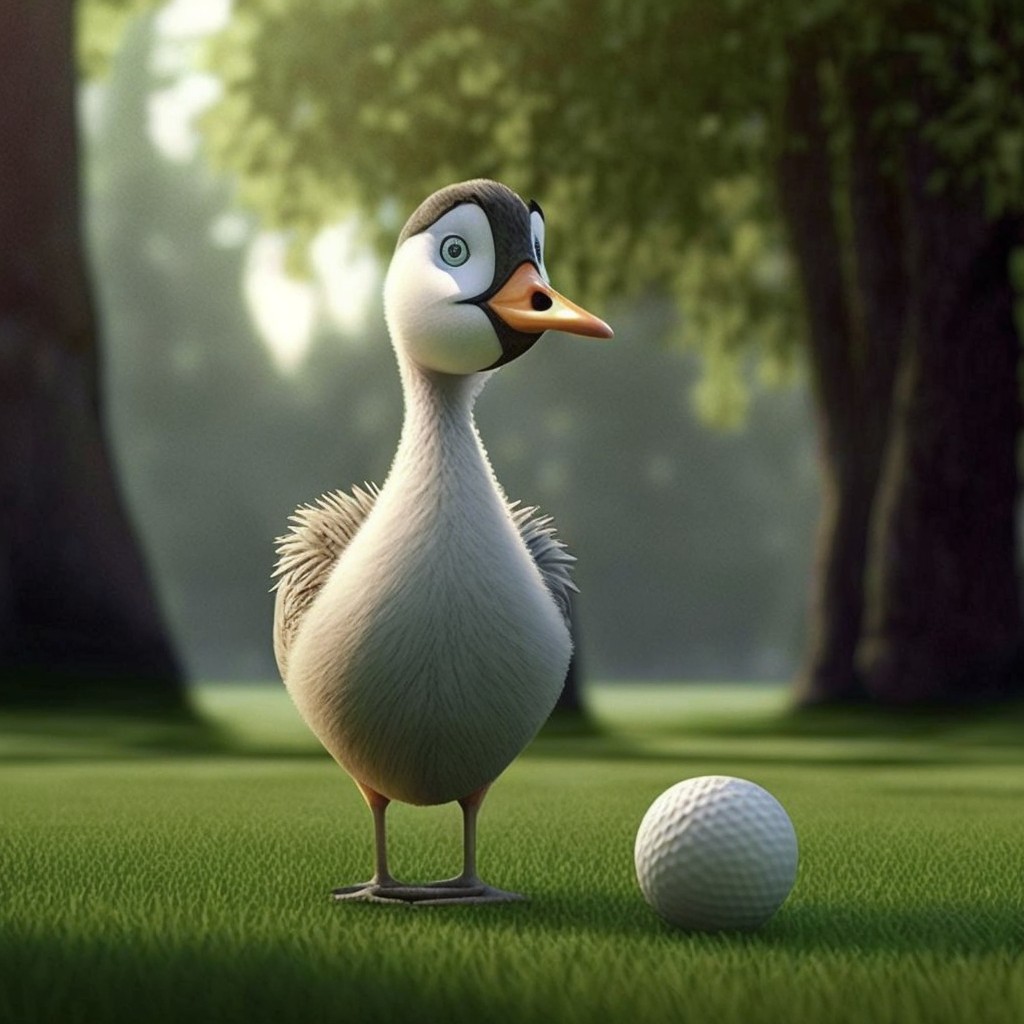
There is not a lot of leeway in terms of the shapes and sizes that golf balls may take. They are often little, round, and seem drab and white, in contrast to the golf clubs. However, they come in a variety of compressions and coverings but they are all the same size. In addition, the adjustments may not seem like much on paper, but they will have a major impact on your play when you go out on the golf course.
Do Golf Balls Come In A Range Of Sizes?
There are two possible answers to the question: yes and no. But you should know that there is only one size and that’s the standard golf ball size which is 4.268 cm. Moreover, golf balls were often larger or smaller prior to the 1980s, therefore it is rare for players to use golf balls of varying sizes these days. The golfing community, however, has created a set of rules that must be followed if one is to compete effectively at the professional level. As a result, if you plan on using the golf ball, it should be of a standard size.
Conventional Dimensions Of A Golf Ball
As mentioned, an official golf ball must have a minimum diameter of 4.268 cm. You can’t go beyond 1.62 ounces of total weight. Both the USGA and the R&A have approved these rules as the gold standard for the sport. This weight and diameter combination is optimal for all golf balls because it provides maximum speed and distance while yet allowing for a moderate amount of spin. To put it simply, the USGA forbids the use of golf balls that are larger or smaller than these specifications in either diameter or weight. So, American golfers caught using these balls will be disqualified from official tournament play.

The Size Of The Golf Ball: A Brief History
The standard size of the golf ball used in U.S. tournaments has remained relatively constant throughout the years. The United States Golf Association (USGA) has always used a golf ball with a diameter of 1.68 inches. Things were a bit different in Europe, however, golfers in the 1980s were given the option of using a smaller-than-normal ball in the British Open championship, one of the oldest and most prestigious golf tournaments in the world.
This ensured that the R&A, golf’s governing body in Britain, met with no pushback when it authorized the smaller, 1.62-inch ball. The United States team in the British Open used a smaller ball despite the USGA’s ban on the usage of replacement balls. Many of the game’s greatest players, like Jack Nicklaus and Arnold Palmer, choose to play with the smaller ball, sometimes known as the British ball. For many years, golfers from both countries couldn’t seem to get along because of the two balls. Before 1990, neither country would authorize the use of a single golf ball in any international competition.
But in 2018, golfing communities throughout the world agreed that a 1.68-inch golf ball should be the golf ball allowed in tournaments. It was a joint effort between the R&A and the USGA to settle on the current golf ball’s diameter and weight. For almost 30 years, 1.68 inches has been the standard golf ball circumference and the correct size.
A Golf Ball’s Dimple Count
Dimples are an essential part of golf ball design because of the huge effect they have on the lift and drag experienced by your ball along its trajectory. There are 336 dimples on a normal golf ball, and each one has an average depth of 0.01 inches. However, the number of dimples on each ball varies. Typically, a golf ball may contain anything from 250 to 500 dimples.
A basic design that has since become a typical component of golf balls was patented in 1905 by an English engineer and manufacturer called William Taylor. According to history: “A ball with more dimples will often go farther.” Shooting the ball from a greater height may seem like a smart idea at first, but in reality, it will result in a shorter overall distance. Number 336 is a popular dimple design because it allows for a good balance between shot height and range.
The Golf Ball’s Density
The average golf ball weight is 1.620 ounces. However, this is the heaviest golf ball weight permitted in case you’re playing in a tournament. As a direct result, today’s standard weight for new golf balls is roughly 46 grams. This weight is just right; it’s neither too light nor too hefty.
Information Regarding Golf Ball Measurements
The best golf balls have come a long way over the course of their existence, developing into very sophisticated plastic and rubber balls. The other side of this is that while innovations in design continue to advance, regulations have tightened. In terms of golf ball rules, the PGA and the USGA are virtually on the same page.
Shape
In order to be considered, the ball must have the key features of a spherically symmetrical ball. That means it should be spherical in form, and the dimples should be evenly spaced over its surface.
Size
The diameter of a golf ball that may be used legally is 4.268 cm. As a result of the ball being able to fit into a hole size that is just 10.795 cm in diameter, the diameter of the ball is almost 2.5 times that of the hole. In addition, golfers decided on this size in 1990 because it fits the requirements set out by both the USGA and the R&A.
Weight
To play a golf game, a ball must weigh 1.62 ounces. All professional competitions, including an open championship, adhere to these standards in order to guarantee that all American players play with balls of the same minimum size.

Find Out Which Golf Ball Size Is Best For You And Why
Golf balls may vary greatly in terms of stiffness, and compression. As an added complication, selecting the best ball to utilize might be difficult. In order to help you choose the best course of action, please consider the following details:
Beginner Level
The standard balls may assist beginner golfers in feeling more at ease and show them why the game is so popular. However, golf balls that have less compression, travel shorter distances yet are easier to hit the target. Thus, if your swing speed is less than 85 miles per hour, you should choose low compression balls. Nevertheless, it will go a fair distance while still keeping a flying that is less difficult to control. In addition, you might try using a longer golf club if you’re having trouble finding the sweet spot. You can do one of these things at any time.
Intermediate Level
Any professional golfer worth his putts knows that there is a seemingly endless selection of golf balls to choose from. Determine which ball is best for your swing by how quickly you hit it. It is our standard practice to advise the average golfer to use a ball with a mid-compression feel. This model is a good option if you haven’t made up your mind on which ball to buy yet. If your swing speeds are in the area of 86 and 105 miles per hour, you’re doing something that’s statistically quite close to the mean. Thus, a ball with medium compression should serve you well.
Differences Between Golf Balls And Ping Pong Balls
The difference in size between golf balls and ping pong balls is negligible, despite the fact that the two types of balls are used for different sports. The diameter of a golf ball is 4.268 cm, whereas the diameter of a regular ping pong ball is 4 cm as same as a tennis ball. As a result, a golf ball is 6.28 percentage points bigger than a ping-pong ball. If you have an older ping pong ball, the diameter can be 38 millimeters rather than 42.
Ping-pong balls have become much bigger over the last several years, which is why this is the case. And J. Jacques is credited with developing the very first ping pong ball in the latter half of the 19th century. The diameter of his ball eventually became the industry standard at 38 millimeters. But in the year 2000, it was enlarged to 40 millimeters, which is the current rule.
Conclusion
We’ve previously said that golf balls exist in a wide range of compressions and coverings. If you play golf sometimes just for enjoyment, you might use the standard golf ball. Also, the perfect golf ball for you depends on your playing style, so try several options to see what works best. To play at the highest levels of professional golf, though, you’ll need to use a mid-compression feel golf ball standard size which is the maximum legal size for tournament play.
It is highly suggested that you constantly practice if you want to participate effectively and legally in professional competitions. Nonetheless, whether you play a game of golf professionally or casual games, understanding how many centimeters are in a golf ball is highly significant since the answer directly affects the trajectory of your golf ball. With this knowledge and sufficient experience, you’ll be able to make a precise shot and have a flight that’s easy to control.
We want to hear from you! Let us know your comments below.

ABOUT THE AUTHOR
Jim has been an avid golfer and golf fan for over 40 years. He started a YouTube channel called Golf Plus about a year ago and it has been wildly successful. It only made sense to expand and reach more golfers with this site and social media. You can learn more about Jim and Golf Plus Media Group by visiting our About Page.






